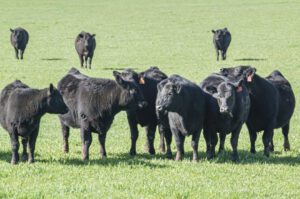Young cows in the cow-calf operation are the genetic future of the herd and represent a large economic investment.
Unfortunately, young cows leave the herd at a higher rate than other age categories.
In many operations, by the time replacement females reach four years old, only about 50 percent of the bred heifers retained are still in the herd, said John B. Hall, beef cattle specialist.
Management strategies to increase young cow retention are important to reducing young cow loss. Some of these strategies include selection, increasing cyclicity/rebreeding rates, and nutritional management post-breeding.
Prepping young cows for success begins at breeding time. First-calf heifers take longer to cycle after calving.
Breeding replacement heifers to calve 20 to 30 days ahead of the cow herd allows them more time to begin cycles before the next breeding season.
This helps ensure that the first-calf heifers breed early in their second breeding season.
One of the main reasons young cows fall out of the herd is they breed late for their second calf and then have trouble breeding within the controlled breeding season in subsequent years.
Body condition of heifers at calving is critical to high pregnancy rates early in the breeding season.
When breeding back for their second calf, heifers calving in body condition score (BCS) Six have pregnancy rates that exceed BCS Five heifers by 15 to 20 percent and BCS Four heifers by 40 to 50 percent. In addition, BCS Six heifers conceive earlier in the breeding season.
Generally, it is recommended that young cows three-and-4four-year-olds are managed to calve in BCS Five. This may require special management or feeding after weaning, as first-calf heifers are often in BCS four or less at weaning.
In addition, since young cows are still growing, they do not gain weight as rapidly as mature cows after weaning.
Research illustrates the effect of calving early versus calving later as first-calf heifers on the retention of heifers in the herd.
By the time cows reach their third calving season, four-years-old, 15 percent more than early-calving heifers, 55 percent, compared to later-calving heifers, while 40 percent are left in the herd.
Therefore, retaining early calving heifers will increase the percentage of young cows in the herd.
Regardless of age, early assistance of cows with calving difficulty increases rebreeding success.
Research indicated a 15 percent greater pregnancy rate in cows that receive assistance early when calving difficulty was detected.
Similarly, using calving-ease bulls to reduce calving difficulty will help with rebreeding percentages.
After calving, young cows lose more weight and body condition than mature cows if they are fed with mature cows. Young cows are still growing, as well as lactating.
This high nutritional demand delays the onset of cycles and impairs conception. If possible, young cows should be gaining weight going into the breeding season.
Nutrient requirements are greater for young cows than for mature cows. The diet needs to contain 10.5 to 11.5 percent crude protein and 61 percent total digestible nutrients.
Nutrient analysis of hay will greatly help with developing diets for young cows. As much as possible, the feeds used should be similar to feeds used for the mature cow herd.
For example, the young cows are fed the best grass/legume hay on the ranch while mature cows receive lower-quality grass/legume hay. Sometimes, supplementation can’t be avoided.
Focusing on supplementing highly digestible fiber byproduct feeds, such as wheat midds, corn gluten feed or distillers’ grains, will maintain the rumen’s ability to digest forages. These feeds also supply protein.
A key aspect of feeding young cows is to separate them from the mature cow herd. Young cows are smaller and at the bottom of the pecking order.
Young cows will spend less time eating and more time moving to avoid boss cows. They also get pushed away from the best feed.
It is highly recommended that two-and-three-year-old cows should be fed together and separated from the mature cow herd. If the four-year-old cows have calved in BCS Four or lower, then they should be fed with the younger cows.
Whether using natural service or artificial insemination (A.I.), synchronizing young cows will help them breed earlier in the breeding season.
Multiple research projects determined that reducing stress during the breeding season increases pregnancy rates, probably through reducing early embryonic mortality.
Moving animals to different forages and environments resulted in decreases in feed intake and bodyweight.
In another study, they found that if animals received nutritional supplementation for 45 days after breeding, it improved early season pregnancy rates, even though heifers were moved from dry lot to pasture.
Other stressors during the breeding season, such as heat or transportation stress, can reduce pregnancy rates.
Determining which management strategies for young cows can be incorporated into an operation will reap benefits. Ranchers have so much invested in young cows that it hurts the operation to lose them.
It’s all right to make cows work for a living, but make sure they have a good chance to succeed.
+++30+++
